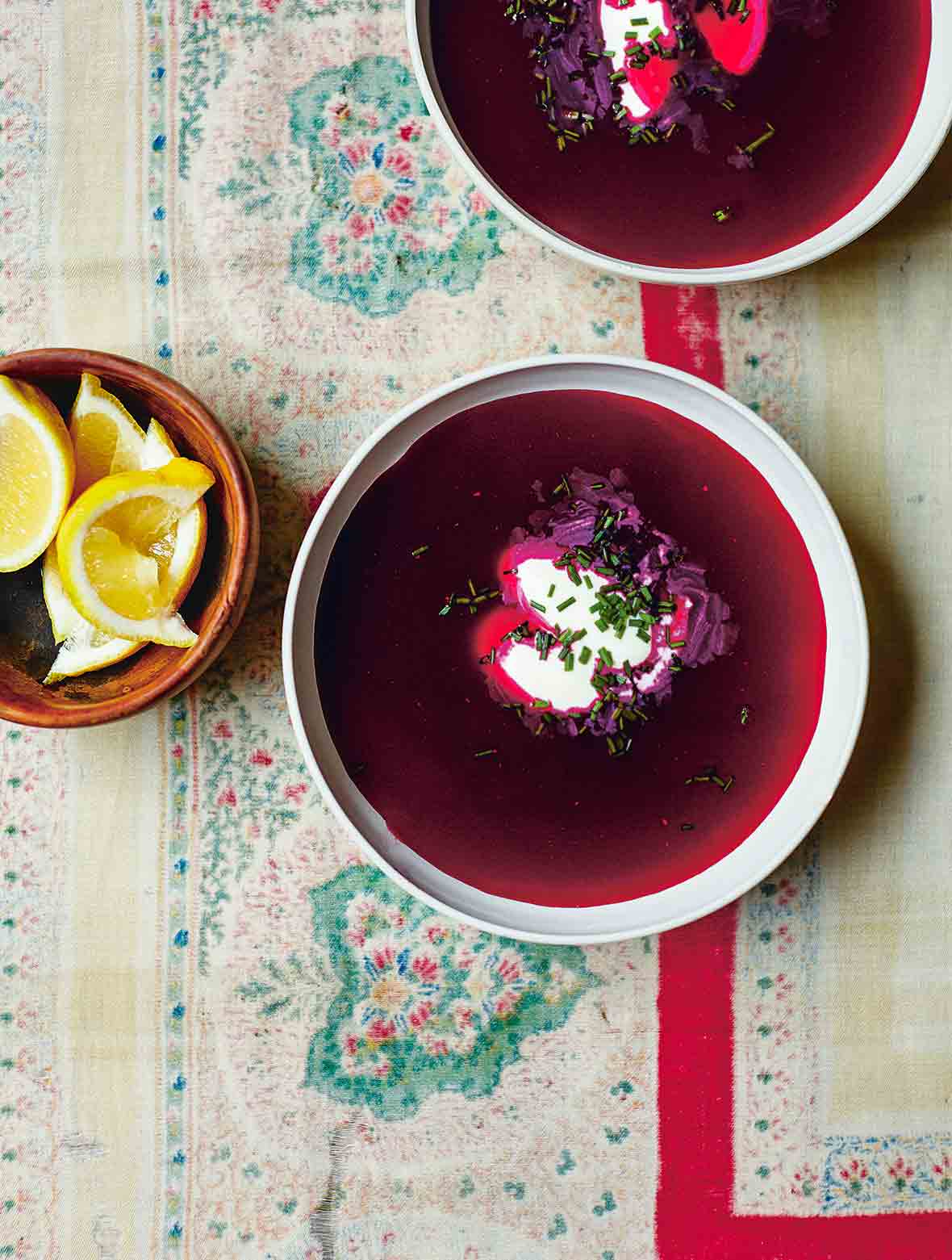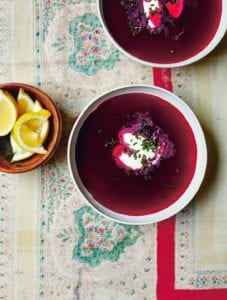
This summer borscht is an easy and elegant version of the traditional robust and hearty beet soup from Eastern Europe. It has a more subdued, subtle beet presence than you’re probably accustomed to and will garner endless accolades when served chilled, whether as a starter, side, or a simple lunch.–Angie Zoobkoff

Summer Borscht
Ingredients
For the borscht
- 4 medium red beets, peeled if desired and coarsely chopped
- 3 medium carrots, coarsely chopped
- 2 celery stalks, chopped
- 1 small onion, coarsely chopped
- One (14.5-oz) can chopped tomatoes
- 1 garlic clove, chopped
- 1 bay leaf
- 4 black peppercorns
- 2 cloves
- 5 cups cold water
- 1 teaspoon granulated sugar
- Sea salt
- Freshly squeezed lemon juice, to taste
To serve
- Heavy cream or sour cream (optional)
- Chives, snipped (optional)
Instructions
- In a large saucepan over high heat, toss in the vegetables, garlic, bay leaf, peppercorns, cloves, water, sugar, and salt.
- Bring to a boil and then reduce the heat to maintain a gentle simmer. Cook until the vegetables are tender, 40 to 60 minutes.
- Strain through a fine mesh sieve, reserving the broth and discarding or composting the vegetables. Let the soup cool.
- Add a squeeze of lemon juice. Taste and, if desired, adjust the salt, pepper, and lemon.
- Cover and refrigerate until chilled through, at least 2 hours and preferably at least 12 hours to allow the flavors to meld.
- Serve the borscht cold, ladled into bowls or poured into cups or shot glasses. If desired, embellish with a swirl of heavy cream or a spoonful of sour cream and a scattering of chives.

Nutrition
Nutrition information is automatically calculated, so should only be used as an approximation.
Recipe Testers’ Reviews
Since marrying into a Russian family, I have had many bowls of borscht. And there have definitely been none quite as light and refreshing as this one. I really enjoyed its freshness and how each of the vegetables shone in this simple broth. There was a strong beet undertone but not overwhelmingly so. Even my hubby, who generally is only a fan of the versions that are heavy on cream and butter and light on beets, enjoyed it.
It was simple to make, and while I’m not sure that the sour cream added anything, it was certainly pretty to look at. (Besides, Russian food generally involves a mandatory dollop of sour cream on everything.)
This borscht was a simple recipe to pull together. The ingredients are easily found and the kitchen smelled AMAZING while this was cooking. I couldn’t wait to taste it. The finished product was beautiful and tasted wonderful.
I can absolutely see it being served in little glasses to guests before dinner out on the lawn or terrace. Kind of a non-alcoholic aperitif. It’s elegant and tasty. Although it’s so thin that I can’t imagine it standing alone. I think I would add a few mini cubed beets to the broth before serving. They could be cooked in a microwave while to broth is simmering so they retain their flavor.
I see myself making this again in the winter but with tiny bits of beets, carrots, and potatoes. It is simply too good not to make again and again I just need to figure out how to make it work for me.
We enjoyed this version of borscht, which results in a refined summer soup with a delicate taste and beautiful color. The procedure filters out almost all of the earthiness of the beets, leaving the slightest hint as to the root source of the color.
I decided on a day that was hot and humid that I would make this for the next day’s dinner, a day that turned out to be cold and rainy. So I haven’t exactly tested out how refreshing it would be on a scorching midsummer day, but my inclination is yes.
Because the flavor is so mild and nuanced, it might even pass muster with those who don’t care for beets. But a word of warning: watch out for spills, drips, or leaks, lest everything in range turn beet-colored.
This is a lovely take on borscht suited for summer. Plus, it’s actually better the next day so it’s something you can make the day before! A quick note: don’t forget the lemon at the end. It brings it all together.
I would say 4 servings if it’s lunch but I could see this also being great as a first course if someone is having a dinner party and then it would be more like 6 servings
The cooling took at least 2 hours. I highly recommend waiting a day before serving. It was so much better the second day!
When I was growing up, borshct was a summertime-in-the-backyard regular (Manischewitz in a glass) and one of the great dining pleasures my father brought to our hybrid Swedish-Jewish family. We loved borscht with a healthy dollop of sour cream.
It hasn’t been since the Horseradish Cream was published on this site that I’ve channeled the Jacobson side of the family so strongly—borscht!
One of my favorite farmers at the market had the beets, carrots, celery, and onion, so I was off to an updated version, from scratch and fresh from the farm. Fast forward to serving the chilled borscht: it was thicker than a broth, took beautifully to the large dollop of sour cream, and I actually skipped the scattering of chives, because it seemed a bit too elegant to suit my memories. None of my tasters felt anything was missing, though if I were to serve this at a full meal in the future, I would likely add the chives for the lovely (and, yes, elegant!) finishing touch. No additional seasoning was needed. When shopping for the chopped tomatoes, I consciously selected salted, so, if using unsalted, perhaps additional salt would be helpful after cooling. Lemon was not needed to brighten the already bright flavor. Also note: my can of tomatoes was 14.5 ounces. I was not sure about how coarsely to chop and I also fretted about whether my simmering temperature was sufficient to create the borscht in the 40 minute cooking time. Neither the extra .5 ounces of tomatoes nor my coarse chopping were at all an issue and the borscht was happily richer and thicker than I had initially envisioned after precisely the 40 minutes specified.
This recipe works as written. The broth is bright and subtly spiced. Though flavorful, this soup is very light fare. Maybe serve it for a very sophisticated group to begin a lunch?














I understand the goal but it seems a waste to sieve out the vegetables– all that fiber.
Stephanie, it’s traditional to have a smooth, brothy borscht. But all is not lost. You can take those strained veggies and their fiber, pop them into a blender, add juice and other goodies, and make a wicked smoothie.
Yea, I GOTTA try this.
Yep, biipboop, it’s pretty damn good!
The recipe looks just like my grandma made it!! I’m trying this immediately.
Excellent, Janice. Tell us what you think.
it was fantastic!
That is wonderful to hear, Janice!